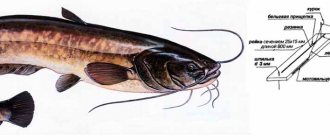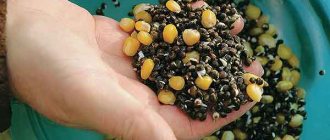The mole cricket, commonly referred to as cabbage weed or earthen crayfish, is a very large insect, reaching a length of 5 cm. It is nocturnal and prefers moist soil. When the air is warm enough, it is capable of flight and is especially active in May. While making underground passages, it gnaws at the root system of garden plantings, for which it received the title of a malicious pest. You can catch a mole cricket using homemade traps and trapping pits. Beer, honey, butter, and cereals are used as bait. The use of eggshells, repellent aromas, and planting of certain plants is also recognized as an effective method of control. All these means are applicable both in open ground and in greenhouses.
How to catch a mole cricket?
Gardeners catch insects in order to reduce their numbers, while fishermen use cabbage grass as bait for catfish and carp. There are several simple ways to catch mole crickets:
- The insect loves moist soil and especially heaps with cow manure and humus. Armed with a shovel, you should carefully turn over the layers of compost. Individuals leaving their shelters are collected and placed in a pre-prepared container.
- In the garden, it is enough to cover the beds with film or cardboard. After 2–3 days, a significant number of mole crickets will gather under the covering material. The number of “catch” depends on the speed of the catcher’s movements and reaction. Insects are very nimble and scatter quickly.
- You can lure the pest at night using a flashlight. To do this, a lighting device is suspended or installed in one area. The mole crickets will crawl towards the light; all that remains is to illuminate the crawling individuals with another flashlight and collect them.
- Another simple way to catch a mole cricket is to throw pieces of soil into the water, wait for the insect to float up and catch it with a net.
- Washing powder will help lure cabbage worms out of their burrows. If nests or underground tunnels are found, pour a solution prepared from 2 - 4 tbsp. l. any powder and 10 liters of water. The components of the mixture create a film and prevent the access of oxygen. After a few minutes, insects begin to leave their shelters en masse. To destroy them, use a shovel, literally cutting the mole cricket in half.
- An alternative to washing powder is soap solution. To prepare it, 100 g of tar or laundry soap should be crushed or grated and combined with 10 liters. water, stir until completely dissolved.
- You can also pour sunflower oil into the passages. First, add 20–50 mg of oil, then 8–10 liters of water.
It is not recommended to catch insects with your bare hands. In attempts to free themselves, mole crickets can painfully scratch the skin.
For storage, jars are used, the bottom of which is lined with wet sawdust. I use plant roots as food. It is advisable that each individual live in a separate container.
How to get rid of mole crickets once and for all
It is very difficult to remove mole crickets from the garden. Of course it is possible. The main thing is not to retreat, to finish the job.
However, there are still people's councils. That is, following which you can try to dig small holes in the fall, about 50 cm deep. Then cover them with old leaves, manure, and straw. These pits serve as a home for mole crickets in winter. When frost sets in, you need to scatter the contents of the pits around the garden. Frost will kill insects.
In the same way, to control pests in your summer cottage, you can use an infusion of onion peels. Pour about 10 liters of boiling water over the onion peel and waste (1 kg) and leave for a week. Water the area with pests with this infusion. The infusion must be diluted with water 1:5 for watering plants. This should be done after rain 3 times every 7 days.
You can also use chicken manure. It is diluted with water in a ratio of 2:10. Mix thoroughly and dilute with water 1:5 and water the ground. The insect does not live in such fertilized soil.
Washing powder diluted in water also destroys mole crickets. The burrows are filled with this solution. Mole crickets also die from baits made from egg shells soaked in vegetable oil. You can shed insect passages with soapy water. Take 200 g of laundry soap, dilute it in a bucket of water and add vegetable oil (0.5 liters per bucket of solution). The oil sticks to the insect and, by closing the trachea, blocks breathing.
How to make a mole cricket trap from manure
For cabbage weeds, dung beetles are a favorite habitat where they feel comfortable, lay eggs, and overwinter. In most cases, contamination of the site occurs through compost. There are several options for traps with manure that allow you to get rid of mole crickets.
First way
Recommended for use in August and early autumn.
- Dig a hole at least 50 cm deep.
- Cover the bottom with plastic wrap.
- Line the bottom with a layer of manure.
- Leave the hole open.
The mole crickets will crawl into the trap in order to spend the winter. When the temperature drops to sub-zero, a hole should be dug. You can spread manure around the area. The insects will not have time to dig deep tunnels and the entire population of pests will die under the influence of frost. There may be several such traps in the garden.
Second way
Such traps are effective both in spring and autumn.
- Dig a hole 0.5 - 0.6 m deep.
- Cover with plastic.
- Fill the third part with cow dung.
- Cover the hole with planks or any hard material, leaving intervals so that the mole cricket can crawl into the hole.
- Cover with covering material to prevent rain.
- A month later, the contents are removed along with the polyethylene and burned. A new trap is being built at the same place.
Third way
This option for using manure against mole crickets can be used in open ground beds or in greenhouse structures.
- Prepare containers: bowls, plastic bottles with the neck cut off, jars, buckets.
- Bury the container so that at least 1 cm remains from the edge of the trap to the surface of the soil layer.
- Fill the containers halfway with manure. To attract pests faster, pour beer or vegetable oil on top.
- Cover the top with thick material and secure by sprinkling the edges with soil.
- After 20–30 days, remove the traps and burn them.
How to use bird droppings against cabbage weed
There are several variations of the effective use of chicken manure:
- Burrows and tunnels are filled with fresh feces.
- Dilute 200 g of fresh litter in 10 liters of water. Fill the discovered nests and underground passages with the resulting solution.
- To prevent the appearance of mole crickets in the autumn, the soil is fertilized with bird droppings.
How to get rid of mole crickets in the garden using chemicals
Are you interested in how to get rid of mole crickets on your property? The most effective way is pesticides. This is a radical method of struggle, which summer residents turn to when folk remedies are ineffective.
To combat the mole cricket, the following pesticides are used: “Aktara 25 WG”, “Prestige”, “Medvetoks”, “Grom” and “Phenoksin plus”. These products are available in the form of powder, granules or liquid. To destroy pests, also use biologically active substances - “Boverin”, “Nemabakt”, etc.
Pesticides have a toxic effect on the body of insects, which leads to their inevitable death
Procedure for using chemicals:
- Read the instructions on the package carefully.
- Determine the location of the pest's last activity (the most recent passages).
- Place poison pellets in the holes. When laying out the poison, cover it well with soil to limit access to it by pets or birds.
- To increase the likelihood of attracting mole crickets to the poison, make baits from fresh manure.
Beer trap
According to farmers, the best bait for mole crickets is beer. With its help you can catch up to 15 individuals in one device. To make a beer trap you will need:
- 0.5 liters of cheap beer;
- 6 wide-neck plastic bottles, 0.5 l;
- 6 small pieces (30x30 cm) of plywood or linoleum to cover the hole;
- 6 pieces of dense linoleum 6x6 cm - backing for the bottle neck.
How to make a trap:
- Pour beer into 6 bottles.
- In places where mole crickets, their burrows or tunnels have been spotted, loosen and moisten the soil to a depth of 15–20 cm.
- Make holes in the prepared soil with a diameter of about 20 cm and a depth of 5–6 cm.
- Place beer bottles in the centers of the holes at an angle of 45°, making sure that the neck of the tilted container does not extend beyond the hole.
- Place a small piece of linoleum under the neck of each so that the insect can crawl into the trap without obstacles and not cover it with soil. If this is not available, wood chips and plywood are used.
- Cover the hole with the trap with any light-proof material: roofing felt, plywood, linoleum, tin.
- Cover the edges with soil. This will maintain moisture and twilight.
There is no need to monitor the contents of traps daily. It is enough to check them once a week. The caught individuals are burned, fresh beer is poured into bottles and installed in new places.
Trap with honey or vegetable oil
Made from a bottle or a jar.
- The walls on the inside are lubricated with honey, so it is more convenient to use containers with a wide neck.
- The prepared jars are dug into the ground, similar to the previous method, covered with dense material and insulated with straw. Cabbage girls who are not averse to eating sweets will not pass by such a treat. But they will no longer be able to get out of the container.
If the number of pests is small, traps are checked every 7–10 days. If there are a lot of mole crickets on the site, then an inspection is carried out every 2 days.
You can put containers with sunflower oil in the same way. The effect is similar to beer and honey.
On a note! The most effective trap for a mole cricket with honey is in the autumn. During this period, insects are preparing for winter and need increased nutrition.
Using bait and linoleum to catch mole crickets
We begin to fight pests in the spring, when the mole cricket begins its move, i.e. by warmth. In May and early June, as soon as it gets dark, in the evening you can often hear the trills of mole crickets, similar to the songs of a cricket. At this time, mole crickets call partners for mating and prepare the nest. We notice this place, and during the day we discover the ground loosened by mole crickets and their passages.
To fight mole crickets using this method, we take pieces of linoleum, a dark film measuring approximately 30x40 cm. We make slightly smaller holes in the ground.
We choose a sunny place for catching mole crickets in the garden, with treated soft soil - where the likelihood of this pest appearing is greatest. By the presence of passages one can judge the presence of a mole cricket.
We prepare a fragrant bait, which can be porridge (preferably rice or pearl barley), lightly greased with fresh unrefined oil for the smell.
We moisten the prepared holes with water, then place the bait in them (about one tablespoon of oiled porridge) and cover the holes with linoleum. Then we sprinkle the edges of the linoleum with soil so that light does not get under it and the moistened soil in the holes does not dry out.
Around 10-11 am we quietly approach the holes and suddenly open the linoleum. When catching mole crickets, you need to do everything quietly and quickly. If you make noise and hesitate, the mole cricket may have time to hide, and then the hole will be empty.
In the hole, the mole cricket sometimes makes vertical burrows. When it is not on the surface, but there are vertical passages, then I pour it out with water and sunflower oil (see below for more on this).
The mole cricket goes into the holes to smell the oily porridge and warm up. After all, the earth cools down during the night, and under the thin linoleum the hole is quickly warmed up by the sun, which is well detected by the sensitive mole cricket.
Here we catch it, squeezing the chest part tightly, and put it in a jar. She is tenacious and will move for a long time.
We dry the caught mole crickets on a warm stove or in the oven (drying in the sun is also possible, but you need to cover them from flies so that they don’t lay eggs).
Dried mole cricket is an environmentally friendly and effective medicine for the treatment of serious illnesses, including tuberculosis.
If necessary, strips of linoleum for catching mole crickets can also be laid on garden paths, with or without porridge in the holes.
Catching mole crickets using cereals
This trap is very easy to make with your own hands. It shows the greatest effectiveness in spring, warm times.
- Cook any of the cereals until half cooked: pearl barley, millet, rice or peas. To enhance the effect, you can add boric acid or an insecticidal preparation. To make the product attractive by smell, add unrefined vegetable oil to it.
- Dig small holes and moisten.
- Place a handful of prepared bait in each.
- Cover with plywood and linoleum. Sprinkle the edges with earth to secure. Such measures will help retain moisture and keep out sunlight.
- In the morning, the covering material is removed and the caught individuals are collected.
Fighting mole cricket larvae
In early June, the mole cricket begins to build a nest, into which it will then lay eggs. The nest can be seen on the surface of the ground with the naked eye. It resembles a hummock, around which, within a radius of several tens of centimeters, the plants have fallen and dried out.
Breaking the ground in this place, you can find a nesting chamber with many yellowish eggs slightly smaller than a pea. The mole cricket often visits its clutch, looking after the eggs - turning them over so that they do not become moldy. Mechanical destruction of the nest at this time is the main and most effective way to combat larvae.
A month later, at the beginning of July, the larvae hatch from the eggs and crawl underground in all directions. They love to live in greenhouses because they have a warm and humid microclimate. Little bears, unlike adults, cannot fly, otherwise they would quickly spread throughout the area.
The mole cricket larva is similar to an adult insect and leads a similar lifestyle. She will become an adult in a year, having moulted five times. But before that time, it will destroy many plants, including many cultivated ones.
The small mole cricket is no less harmful to the adult individual; methods of combating this dangerous insect therefore need to be combined. The fight can be mechanical and chemical.
In the southern regions, mole crickets lay eggs until September. It is better to fight the larvae that have spread throughout the area using a radical method, that is, chemically. For destruction, poisoned baits are used:
- Phenoksin, Medvetsid, Medvetoks, Grom - pour into the hole and cover the top with soil to prevent birds. Young mole crickets will definitely flock to the scent that is attractive to them and taste the poisonous pellets.
- Boil half a kilo of any cereal, add a tablespoon of “fragrant” vegetable oil (its smell attracts mole crickets) and an ampoule of regent, karbofos, metaphos or zinc phosphide. Spread the bait underground over the entire area, a tablespoon per bed.
How to catch a mole cricket with a bucket
Another accessible way to lure out a mole cricket yourself. It is used in May and June, when cabbage mushrooms become active, are absorbed in mating games and their years are observed.
- A wide bucket with a soap solution is installed on the site.
- A bright lantern is placed above the bucket.
Attracted by the bright light, individuals hit the lighting fixture and fall into soapy water, from which they can no longer get out. Judging by the reviews, during the peak season it is possible to collect half a bucket of mole crickets in one night.
Eggshell
Traps with eggshells are good at saving garden plantings from mole cricket invasions.
- Grind the eggshells and sprinkle them with sunflower oil. You can add cereal, cooked until half cooked.
- Place bait in the ground.
- After eating the bait, the insects' digestive system is injured and they die.
On a note! An easier way to use eggshells involves burying the crushed product in the soil. Constantly bumping into sharp objects, mole crickets will look for other habitats.
Biological preparations for the fight against mole crickets
Summer residents often wonder how to get rid of mole crickets in their summer cottage without harming beneficial insects and other inhabitants. The optimal solution may be biological preparations that contain a microorganism that is not toxic to birds, animals and humans, but is harmful to mole crickets. Examples include the drugs Nemabact and Boverin.
"Nemabakt" is a successful symbiosis of a predatory nematode and a bacterium. The nematode penetrates the mole cricket larva, infecting it with bacteria that decompose the insides of the insect. A package of the drug is enough for 1 hundred square meters.
In order for the drug to maintain its effectiveness, it is important to strictly observe the storage and transportation conditions. Before use, the drug must be stored in the refrigerator, and during transportation and application to the soil, the temperature should not exceed 25°C. The drug "Boverin" is the spores of the fungus Beauveria bassiana, which causes Muscardine disease
This drug is especially effective when used in greenhouses. Fungal spores land on the insect, grow through the cover and grow inside the body, inevitably leading to death.
Summary
Mole cricket traps help to significantly reduce the population size, but they are not able to completely rid an area of pests. For effective control, comprehensive measures are used: the roots of plants are treated with insecticidal preparations before planting, and the soil is loosened and dug up in a timely manner. To deter them, chrysanthemums and marigolds are planted, aspen stakes are installed, and the soil is mulched with pine needles. To prevent mole crickets from entering the greenhouse, deep furrows are made along the perimeter of the structure, sprinkled with sand and sprayed with kerosene.
Harm
The main danger is the destruction of the crop. Having appeared on the site in single copies, the mole cricket reproduces very quickly. Numerous hordes quickly destroy the harvest of root crops: potatoes, radishes, radishes, carrots, and beets. They do not disdain the young roots of planted seedlings of tomatoes, cabbage, onions and cucumbers lying on the surface of the ground.
It causes great harm to shrubs, eating up plant roots, as well as bulbous plants (tulips, lilies, gladioli, etc.), strawberries, watermelons, melons. The voracious bug feeds not only on plant foods; it also uses earthworms, larvae, and small insects.
It is easy to notice the appearance of insects in the garden. Making their tunnels underground, mounds of earth are visible on the surface of the soil. The pest is especially active in the spring, when the earth warms up. That is why gardeners perceive this insect as their worst enemy. You will have to put in a lot of effort and time to get rid of it forever.











